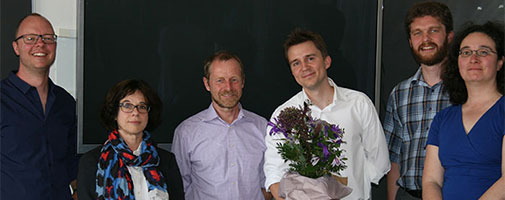Stort til lykke til Rasmus Anker Pedersen

Rasmus Anker Pedersen sammen med bedømmelsesudvalget og vejledere. Fra venstre Peter Langen (vejleder, DMI), Pascale Braconnot (bedømmelsesudvalg), Eigil Kaas (formand for bedømmelsesudvalg), Rasmus Anker Pedersen, Bo Vinther (vejleder) og Masa Kageyama (bedømmelsesudvalg).
Stor til lykke til Rasmus Anker Pedersen fra Center for Is og Klima, som med stor succes forsvarede sin ph.d.-afhandling mandag d. 20 juni, 2016.
Rasmus har i sit ph.d.-projekt benyttet klimamodeller til at undersøge om fortidens varme klima (Eem-tiden, for 125.000 år siden) kan gøre os klogere på fremtidens globale opvarmning. Resultaterne viser, at Eem-tiden ikke er en optimal parallel til fremtidens klima, især ikke for afsmeltningen fra indlandsisen på Grønland. Ændringer i den Arktiske havis spiller dog en central rolle i både fortiden og fremtidens klimaændringer, og kan påvirke klimaet både i og udenfor Arktis.
Rasmus fortsætter som postdoc på Center for Is og Klima, og skal arbejde med klima- og isflydemodellering som en del af ice2ice-projektet.
Her afhandlingens titel og abstract:
Modelling interglacial climate – investigating the mechanisms of a warming climate
ABSTRACT Past warm climate states could potentially provide information on future global warming. The past warming was driven by changed insolation rather than an increased greenhouse effect, and thus the warm climate states are expected to be different. Nonetheless, the response of the climate system involves some of the same mechanisms in the two climate states. This thesis aims to investigate these mechanisms through climate model experiments. This two-part study has a special focus on the Arctic region, and the main paleoclimate experiments are supplemented by idealized experiments detailing the impact of a changing sea ice cover.
The first part focusses on the last interglacial climate (125,000 years before present) which was characterized by substantial warming at high northern latitudes due to an increased insolation during summer. The simulations reveal that the oceanic changes dominate the response at high northern latitudes, while the direct insolation impact is more dominant in the tropics. On Greenland, the simulated warming is low compared to the ice core reconstructions. Surface mass balance calculations indicate that the oceanic conditions favor increased accumulation in the southeast, while the insolation appears to be the dominant cause of the expected ice sheet reduction.
The second part explores the atmospheric sensitivity to the location of sea ice loss. Three investigated sea ice scenarios with ice loss in different regions all exhibit substantial near-surface warming, with maximum warming occurring in winter. The three scenarios all affect the climate beyond the Arctic, especially the mid-latitude circulation which is sensitive to the location of the ice loss.
Together, the results presented in this thesis illustrate that the changes in the Arctic sea ice cover are important for shaping both past and future warm climate states. Nonetheless, the last interglacial is not an ideal analogue for future climate changes, as the changed insolation has a large impact – especially on the Greenland ice sheet.
